Figurative language refers to words or phrases that express meaning but deviate in the literal or conventional understanding of said words or phrases.
It is a form of language that uses figures of speech, such as metaphors or similes, to convey persuasive and impactful messaging.
Below we will review the elements of figurative language, including how to craft your own messaging using a more creative tone out in the world.
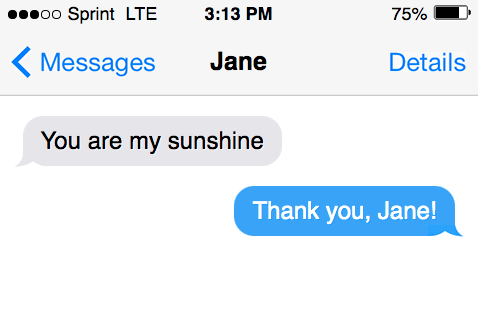
What is figurative language? Have you experienced figurative language being used?
Think back to the last time you were in an informal social situation with a group of people. Perhaps a work event, dinner with friends, or a family celebration.
It’s likely that during this time, at least two people shared a personal story with the group.
Now, think about which story stood out to you more and was more enjoyable to listen to: was it the story that simply communicated an event very coldly and factually, or the story that included descriptions, references, and had multiple twists and turns?
If your answer is the second scenario, then you’ve probably witnessed the use of figurative language at work first-hand!
To fully understand how and why figurative language is successful, it’s crucial to grasp the context with which it is used.
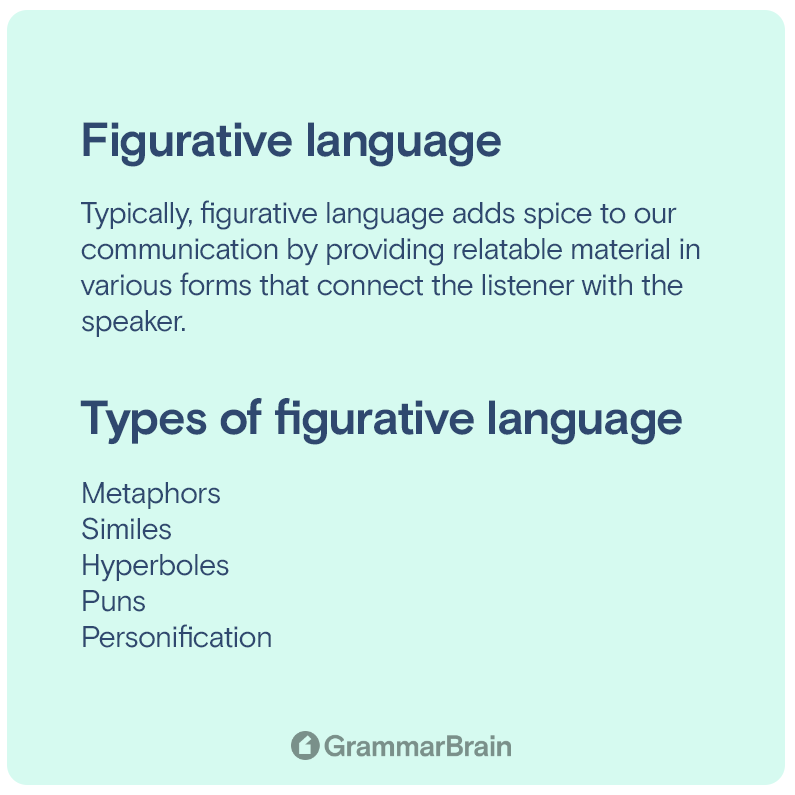
Contexts of figurative language use
Typically, figurative language adds spice to our communication by providing relatable material in various forms that connect the listener with the speaker.
If we did not speak with figurative language during informal social conversations, chances are our stories and conversing would be pretty dry and difficult to follow.
That said, non-figurative language, or “literal language”, is often best used in formal situations, such as with professional communications and academic papers.
This is very contextual, requiring the speaker to read the scenario to ensure that figurative language would be appropriate.
To determine if figurative language is appropriate, we must first examine the different types of figurative language that can be used.
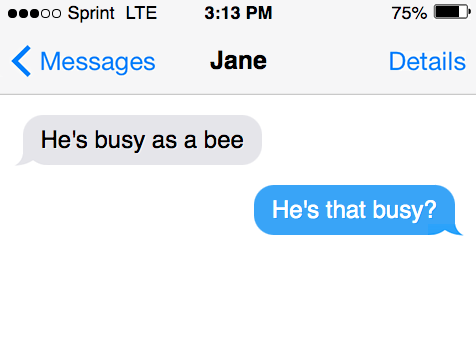
Different types of figurative language
Within the figurative language family, many different figures of speech can be used.
Below we take a closer look at six different figures of speech that you can use in various communications.
6 types of figurative language:
- Metaphors
- Similes
- Hyperboles
- Puns
- Personification
- Symbolism
Metaphors
A metaphor is “a word or phrase literally denoting one kind of object or idea is used in place of another to suggest a likeness or analogy between them” (Merriam-Webster).
That is, metaphors state that one thing is the same as another for the sake of comparison.
Metaphors will only make sense when the comparison between two things is universally known.
Most often used in literature, such as poetry, metaphors can also be used during verbal communications to add spice to the conversation.
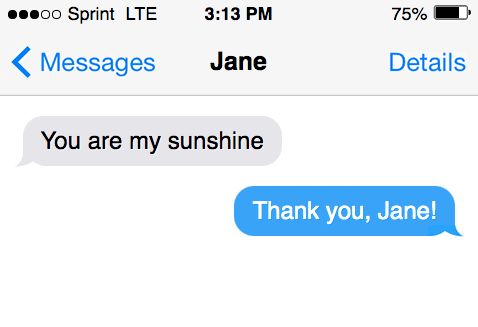
Examples of metaphors:
- “The world is your oyster”
- Meaning: life offers up many opportunities that are available to you.
- “Time is money”
- Meaning: time is a valuable resource.
- “You are my sunshine”
- Meaning: you are the light source of my life.
Similes
Not to be confused with metaphors, similes (pronounced si-muh-lee) are figures of speech that also makes a comparison between two separate concepts, but with the connecting words of “like” or “as.”
That is, rather than saying some is something else (such is the case with metaphors), similes more so reference similarities, which is a great way to remember their purpose as well (simile = similar).
Like the other figures of speech, Similes steer away from literal language.
Examples of similes:
- “He’s busy as a bee”
- Meaning: suggesting that, as bees spend their lives working, he is consumed similarly with his own work.
- “She climbs like a monkey”
- “My mouth was as dry as bones”
- Meaning: calling a similarity between dry and brittle bones to a parched mouth.
Hyperboles
One of the more bold forms of figurative language, hyperboles use intentional exaggerations in order to emphasize the importance of opinion in contract to literal meaning.
Using this figure of speech is more often associated with humor and specifically leans on the ‘ridiculous’ lens instead of using literal language.
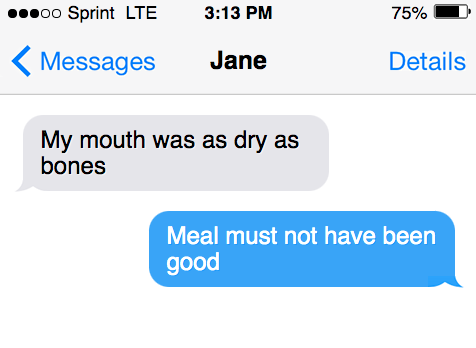
Examples of hyperboles in everyday speech:
- “I have a million things to do today!”
- Meaning: it would be unrealistic to accomplish one million tasks in a day, so the meaning here relates to being very busy.
- “She runs faster than the speed of light!”
- Meaning: this is literally impossible, but it suggests that her running skill is highly impressive and extremely fast.
- “I’m so hungry, I could eat a horse!”
- Meaning: also an impossible feat, this hyperbole makes reference to being hungry enough to eat a very large meal.
Puns
Not just reserved for dads, a pun is most commonly known as a play on words. What distinguishes puns from the other figures of speech is the involvement of words with similar sounds but with different meanings.
Like hyperboles, puns are most often used in satirical circumstances for the sake of creative wording verbally and literarily.
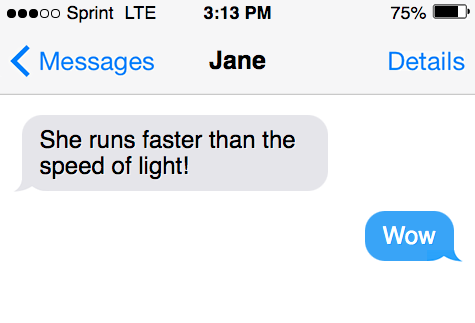
Examples of puns in everyday speech:
- “This vacuum sucks”
- Meaning: this makes reference to the literal purpose of a vacuum, to “suck” up objects, but also is making reference to the quality of the vacuum (sucking = not doing the job properly).
- “The wedding cake had me in tiers”
- Meaning: this pun would be better used with literary devices, as the meaning is more pronounced when read. The phrase “had me in tiers” sounds like “had me in tears”, the difference being that there are literal tiers in a wedding cake. This pun makes reference to the literal structure of the cake (tiers) and associates a feeling of witnessing the cake (being brought to “tears”).
Personification
Have you ever seen a dog walking on the street wearing a sweater? This might indicate that their owner has personified them and projected human qualities onto them.
Personification can also be used in reference to inanimate objects and natural elements that make an association with human characteristics.
Personification is unique among literary devices and other examples of figurative language in that it is non-literal in conveying thoughts and ideas.
Examples of personification:
- “The wind howled”
- With this example, there is an association being made between wind (a natural element) with a loud sound from an animal (howling) to suggest that the wind is making a loud noise. Unlike similes, personification involves more of a statement rather than a reference, also there is no literal meaning.
- “The words leapt off the page”
- Perhaps in reference to an Emily Dickinson or William Shakespeare literary device, this use of personification bypasses any literal meanings (words of course cannot move) to suggest that what the words were conveying caused much excitement to the reader. Use of this form of figurative language helps in the literary sense to build imagery to make a point.
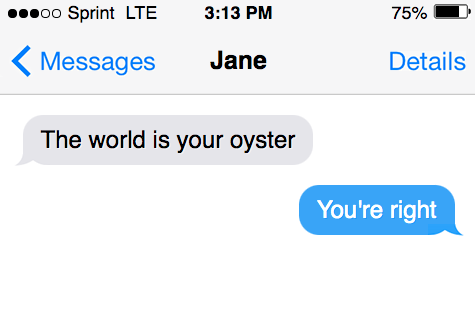
Other common figurative language’s
It’s not uncommon for these types of figurative language to appear in American English and literature:
Key takeaways
Whether you are using figurative language as a form of expression, to enhance your literary competency, or to share a funny story, you have many different types at your disposal that can add a colorful tone to your language.
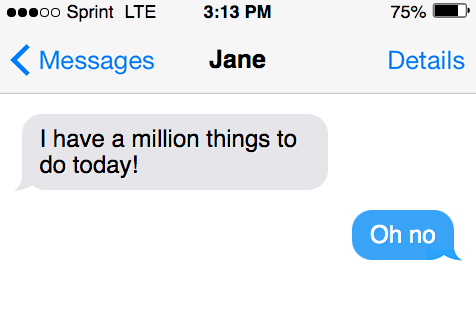
When opting to use figures of speech in your verbal or literary communications, there are a few key things to keep in mind:
A. Try to use figures of speech sparingly
- Given that it is a “spice” to the conversation, use it similarly to spices in cooking – less is more!
B. Pair your figures of speech with humor
- Figurative language comes across as easiest and best in situations when one is being humorous. This will help mitigate any potential for miscommunication.
C. Simplicity is best
- If there is a potential for a message to get lost in your communications, opt to keep it simple and limit figurative language. Best to be direct than overly complicated.
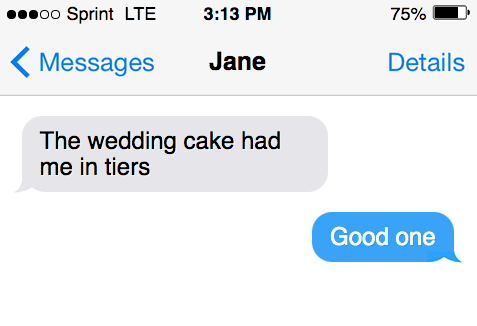
Glossary
Glossary of terms and references in this guide.
What are literary devices?
Literary devices include irony, imagery, symbolism, personification, hyperbole, and juxtaposition. Learn more about literary devices here.
What is literal language?
Literary language is the form of language used in written literature, which can be a nonstandard dialect or a standardized variety. Learn more about literary language here.
What are human characteristics?
Human characteristics are “integrity, courage, self-awareness, and wholeheartedness.” Learn more about human qualities here.
Sources
- Howling – Wikipedia
- Personification Definition & Meaning – Merriam-Webster
- Bring tears to one’s eyes Definition & Meaning
- Examples of Hyperbole: What It Is and How to Use It
- Dad joke – Wikipedia
- Pun Definition & Meaning – Merriam-Webster
- Eat a horse Definition & Meaning – Merriam-Webster
- (I’m so hungry), I could eat a horse – Cambridge Dictionary
- Busy As A Bee (And Other Pest-Related Idioms)
- Exaggeration – Wikipedia
- What is a Simile? – J.J. Pryor – Medium
- The Great Gatsby by F. Scott Fitzgerald – Goodreads
- Onomatopoeia – Wikipedia
- Synecdoche – Wikipedia
- Idioms and phrases
Inside this article
Fact checked:
Content is rigorously reviewed by a team of qualified and experienced fact checkers. Fact checkers review articles for factual accuracy, relevance, and timeliness. Learn more.
Core lessons
Glossary
- Abstract Noun
- Accusative Case
- Anecdote
- Antonym
- Active Sentence
- Adverb
- Adjective
- Allegory
- Alliteration
- Adjective Clause
- Adjective Phrase
- Ampersand
- Anastrophe
- Adverbial Clause
- Appositive Phrase
- Clause
- Compound Adjective
- Complex Sentence
- Compound Words
- Compound Predicate
- Common Noun
- Comparative Adjective
- Comparative and Superlative
- Compound Noun
- Compound Subject
- Compound Sentence
- Copular Verb
- Collective Noun
- Colloquialism
- Conciseness
- Consonance
- Conditional
- Concrete Noun
- Conjunction
- Conjugation
- Conditional Sentence
- Comma Splice
- Correlative Conjunction
- Coordinating Conjunction
- Coordinate Adjective
- Cumulative Adjective
- Dative Case
- Determiner
- Declarative Sentence
- Declarative Statement
- Direct Object Pronoun
- Direct Object
- Diction
- Diphthong
- Dangling Modifier
- Demonstrative Pronoun
- Demonstrative Adjective
- Direct Characterization
- Definite Article
- Doublespeak
- False Dilemma Fallacy
- Future Perfect Progressive
- Future Simple
- Future Perfect Continuous
- Future Perfect
- First Conditional
- Irregular Adjective
- Irregular Verb
- Imperative Sentence
- Indefinite Article
- Intransitive Verb
- Introductory Phrase
- Indefinite Pronoun
- Indirect Characterization
- Interrogative Sentence
- Intensive Pronoun
- Inanimate Object
- Indefinite Tense
- Infinitive Phrase
- Interjection
- Intensifier
- Infinitive
- Indicative Mood
- Participle
- Parallelism
- Prepositional Phrase
- Past Simple Tense
- Past Continuous Tense
- Past Perfect Tense
- Past Progressive Tense
- Present Simple Tense
- Present Perfect Tense
- Personal Pronoun
- Personification
- Persuasive Writing
- Parallel Structure
- Phrasal Verb
- Predicate Adjective
- Predicate Nominative
- Phonetic Language
- Plural Noun
- Punctuation
- Punctuation Marks
- Preposition
- Preposition of Place
- Parts of Speech
- Possessive Adjective
- Possessive Determiner
- Possessive Case
- Possessive Noun
- Proper Adjective
- Proper Noun
- Present Participle
- Prefix
- Predicate



